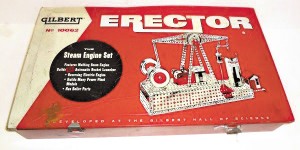The commute from New York City to New Haven by rail was tedious, at best, in 1911. Yet, it would be on one such trip that manufacturing mogul Alfred Carlton Gilbert would find the inspiration that would garner him a spot in toy making history.
Taking his idea from the equipment used by workmen electrifying the tracks along his daily route, he envisioned a conglomeration of miniature metal beams, pulleys, gears and wheels that could be assembled and disassembled into dozens of differing forms. A motorized toy that would be “educational, instructive and amusing.” A toy that would become the heart of the first major advertising campaign in American toy manufacturing history. In 1913 that toy was released as the “Erector/Structural Steel and Electro-Mechanical Builder.” Today we know it as the “Erector Set.”
While building sets had existed for some time, the Erector Set produced in 1913 by the Mysto Manufacturing Company (reorganized in 1916 as the A. C Gilbert Company) was the first to include a motor. This innovation to steel building sets would be just one of many transformations the toy would see through its long history. Knowing these changes through the years can be most helpful in determining the age. One of the easiest ways to identify older “Erectors” is by their packaging. From 1916-1932 the sets were sold in wooden boxes; from 1933-1962 those were replaced by steel boxes painted in red, green, or blue; and from 1950 forward all boxes were painted red.
Age can also be approximated by the changes in Erector sets through the years. The year 1924 saw the introduction of the first curved girders which allowed for the construction of trucks, zeppelins and Ferris wheels. The largest Erector ever produced (and a must-have for collectors) came with the release of the 150 pound #10 set, appropriately nicknamed “The Climax of Erector Glory.” Two major changes during the 1940s were the inclusion of the Parachute Jump and the substitution of wooden girders in place of steel during the war years. In 1950 the company changed their marking from 12/12 to a different serial number for each model and later.
A. C. Gilbert saw great accomplishments during his life time. He was a talented magician, a graduate of Yale Medical School, a record-holding athlete, a genius in the field of marketing, and a noted inventor with over 150 patents to his credit. But to many in the field of toy manufacturing his greatest achievement came in the fall of 1918 when the government considered banning the production of metal toys to assist the war effort. Combining his congenial personality and his insight into human nature, Gilbert went to the Council of National Defense to plead his case.
Realizing the mindset of those he was addressing, he ended his presentation by gifting each member of the council with a miniature Erector tank and these words, “children not only play with toys, they learn from them. Toys help a child to develop a sense of what is important, including a responsibility to their country and its military efforts.” The Council dismissed their plans to ban toy production and Gilbert was celebrated in the press as “the man who saved Christmas.” Later in life he would tell a friend it was his most cherished accomplishment.
After Gilbert’s death in 1961 the company steadily declined. The Erector was redesigned in an effort to keep up with the times, but found it could not compete with the realistic scale model toys flooding the market. The A.C. Gilbert company filed for bankruptcy in 1967 after an illustrious 54 year run that produced over 30 million Erector Sets. In a fitting tribute the life and work of A.C. Gilbert, the Erector Set was inducted into the National Toy Hall of Fame in 1998. Until next time . . . Linda
Linda Kennett is a professional liquidation consultant specializing in down sizing for seniors and the liquidation of estates and may be reached at lkennett@indy.rr.com or 317-258-7835



